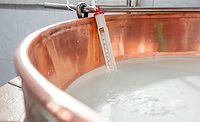Keeping Glass and Brittle Plastic Out of Products

Image credit: Vindemia via Unsplash
Years ago, I conducted an audit at a facility, during which I was rather stunned by a comment made by the quality manager at the plant. I asked him to explain their glass and brittle plastic program, and his response was, "We are not a glass packer. We do not need one." I had to explain that it applies to all food processors, including their plant.
So, what should make up a glass and brittle plastic program?
The objective of such a program is to minimize the potential for cross-contamination of food, ingredients, and packaging with glass or brittle plastic to ensure that foods and ingredients are safe and will not result in an injury or illness to end users.
The next step is to establish a policy keeping all glass or ceramics out of the production area except for glass packaging. One does not want persons from the office walking out to the production floor with bottles, coffee mugs, or glasses. It also means that watches must be kept in lockers. Lastly, every operation will have workers who wear eyeglasses. Glasses should be manufactured from shatterproof materials, or the workers with eyeglasses must wear eye covers.
Facility Design Considerations
There are usually windows or skylights in the production area and the warehouse. These windows should be manufactured from shatterproof glass or coated/covered with plastic to contain breakage. Every part of the facility will have lights of some sort. All lightbulbs should be shielded to contain breakage or be manufactured of unbreakable material. The facility should be designed or modified so that lights are recessed into walls or ceilings to help protect bulbs and reduce the chances of breakage.
These two elements of the program are designed to minimize the potential for product contamination. The next step is to inventory all glass and brittle plastics in areas where foods, ingredients, and packaging are stored or handled. This includes the warehouse, production, and packaging areas. When conducting the inventory, note the location of glass or plastic, the type of glass or plastic (if possible), and whether it is shielded or strengthened in any way. This inventory must also include the area or areas where glass is stored. The inventory must include all glass and brittle plastic, as noted above. This means light fixtures, gauge covers, lights and mirrors on fork trucks, thermometers and other monitoring devices, and anything else that could possibly break and contaminate product. Once the inventory has been completed, it is up to plant management and the food safety team to examine the master list of glass and brittle plastic and determine whether any of the situations existing within the plant pose a realistic threat of contamination and potential injury. Each location should be assigned a risk rating (high, medium, or low risk) based on the potential for contamination.
If any of the glass or brittle plastic locations are deemed to pose a realistic threat (high), then that situation shall be addressed as soon as possible, and corrective actions will be noted on the master list. An example of a critical risk might be a window overlooking production that is not shatterproof. Corrective actions may include (but not be limited to) the use of shields or covers, replacement with stronger or shatterproof plastics, or removal of the window from the production or holding area.
Auditing and Training
Once the master list for glass and brittle plastic has been established, the processor shall establish a regular audit program to check the condition of every piece of glass and brittle plastic noted on the master list to determine its condition. If any breakage, damage, or noncompliant situations (for example, a missing light cover) are noted, they shall be recorded on the master list and repairs shall be implemented immediately. The company should also determine what happened and take steps to prevent a reoccurrence. These audits should be conducted several times per year. Some facilities conduct these audits monthly.
The glass and brittle plastic program should be addressed during orientation for new employees and during yearly refresher sessions. One element that must be include in the orientation is to emphasize the importance of reporting any broken glass or brittle plastic, such as cracked gauge covers or windows, that might be observed during a normal work day. Another issue that must be included in the glass and brittle plastic program and as part of new employee orientation is transporting glass through the plant. Whenever glass is transported through the plant, it must be protected and contained in some way. For example, lights must be carried in their original box when being moved for replacement. If the individual drops the box and the glass does break, then it will be contained in the package.
Glass Packaging Considerations
If the food processor packs its products in glass jars or bottles, then its program must take into account the potential for glass breakage and how to respond to a glass breakage incident. The program should also include glass cleanup and glass washing procedures.
When a glass bottle breaks on the line, regardless of whether it is empty or full, there needs to be a documented procedure for how to respond. This procedure must be addressed as part of the orientation. The procedures might read as follows.
If glass or brittle plastic breaks in the production area or warehouse, then operations must cease immediately. All exposed product shall be segregated and placed on hold. Some glass packers mandate that all product or glass bottles/jars withing six feet of the breakage be thrown away. Workers in the area of the breakage shall remain in place and not move throughout the plant, so as not to spread the broken glass or brittle plastic through the plant. Shoes shall be inspected prior to leaving the area and cleaned, if needed. Broken glass and brittle plastic shall be cleaned using designated tools and disposed of into designated containers.
Glass and plastic breakage shall be recorded in a Glass and Brittle Plastic Breakage Log. The log shall note the type of breakage, the location, whether any product was affected, and the disposition of said product. Plant management shall meet to discuss all incidents, determine the root cause(s), and implement a corrective/preventive action plan to eliminate or minimize the potential for future incidents.
Most glass processors have a glass washer of some kind upstream of the filler. The washer may use water or high-pressure air. The company must validate that the washer will effectively remove foreign materials such as glass or other potential contaminants. This is done by spiking bottles or jars with a known number of shards of glass or other contaminants, running the spiked sample through the bottle washer, and rinsing the bottle to remove any residual contamination. The rinse water is poured through a filter to determine whether any of the materials remained after the washer. If there is residual contamination, then the washer parameters must be modified until the washer is shown to effectively remove all of the materials that were placed in the glass. Ideally, a processor should run at least two studies to properly validate the washer.
That is a glass and brittle plastic program in a nutshell. The hardest part is probably putting together the inventory, as there will be many potential glass and brittle plastic contaminants because of lighting, gauge covers, forklifts, and other equipment. Once the inventory is completed, however, it is simply a matter of maintaining and updating the master list and conducting regular checks. Remember the mantra: Develop, document, implement, and maintain with verification and routine checks, which are an integral element of maintenance.
Looking for a reprint of this article?
From high-res PDFs to custom plaques, order your copy today!









